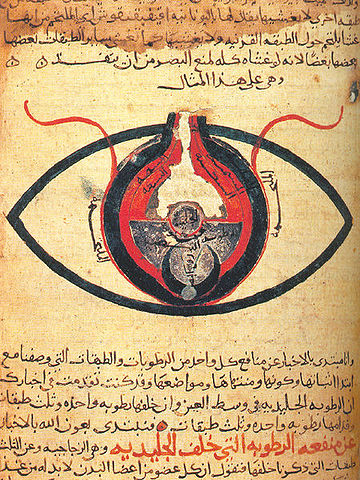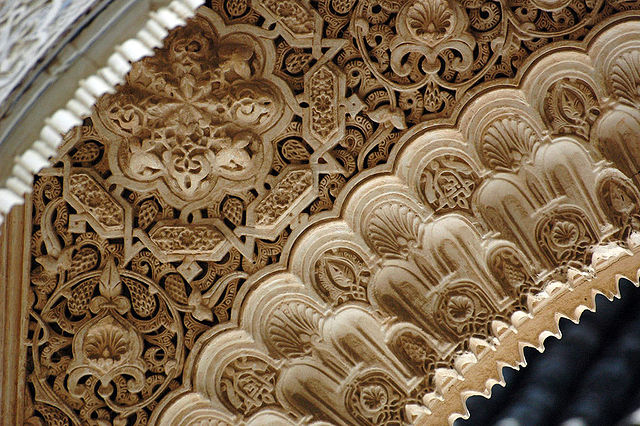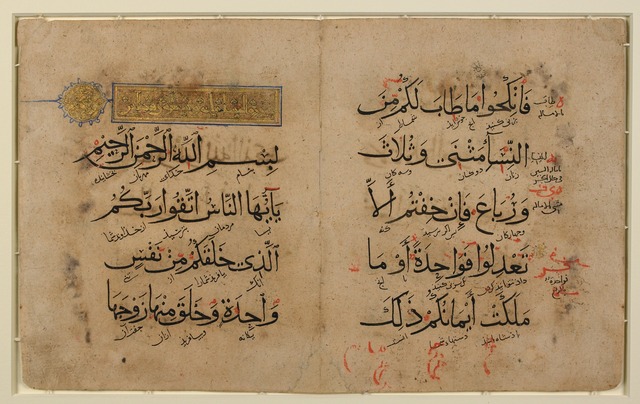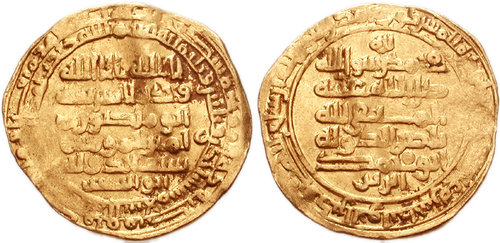7.3: The Islamic Golden Age
- Page ID
- 72242
Learning Objective
- Identify the causes of, and developments during, the Islamic Golden Age
Key Points
- The Islamic Golden Age started with the rise of Islam and establishment of the first Islamic state in 622.
- The introduction of paper in the 10th century enabled Islamic scholars to easily write manuscripts; Arab scholars also saved classic works of antiquity by translating them into various languages.
- The Arabs assimilated the scientific knowledge of the civilizations they had overrun, including the ancient Greek, Roman, Persian, Chinese, Indian, Egyptian, and Phoenician civilizations.
- Scientists advanced the fields of algebra, calculus, geometry, chemistry, biology, medicine, and astronomy.
- Many forms of art flourished during the Islamic Golden Age, including ceramics, metalwork, textiles, illuminated manuscripts, woodwork, and calligraphy.
Terms
Averroës
A medieval Andalusian polymath famous for his translations and commentaries of Aristotle.
calligraphy
A visual art related to writing—the design and execution of lettering with a broad tip instrument or brush in one stroke.
arabesque
A form of artistic decoration consisting of surface decorations based on rhythmic linear patterns of scrolling and interlacing foliage, tendrils, and other elements.
Overview
The Islamic Golden Age refers to a period in the history of Islam, traditionally dated from the 8th century to the 13th century, during which much of the historically Islamic world was ruled by various caliphates and science, economic development, and cultural works flourished. This period is traditionally understood to have begun during the reign of the Abbasid caliph Harun al-Rashid (786–809) with the inauguration of the House of Wisdom in Baghdad, where scholars from various parts of the world with different cultural backgrounds were mandated to gather and translate all of the world’s classical knowledge into the Arabic language.
The end of the age is variously given as 1258 with the Mongolian Sack of Baghdad, or 1492 with the completion of the Christian Reconquista of the Emirate of Granada in Al-Andalus, Iberian Peninsula. During the Golden Age, the major Islamic capital cities of Baghdad, Cairo, and Córdoba became the main intellectual centers for science, philosophy, medicine, and education. The government heavily patronized scholars, and the best scholars and notable translators, such as Hunayn ibn Ishaq, had salaries estimated to be the equivalent of those of professional athletes today.
The School of Nisibis and later the School of Edessa became centers of learning and transmission of classical wisdom. The House of Wisdom was a library, translation institute, and academy, and the Library of Alexandria and the Imperial Library of Constantinople housed new works of literature. Nestorian Christians played an important role in the formation of Arab culture, with the Jundishapur hospital and medical academy prominent in the late Sassanid, Umayyad, and early Abbasid periods. Notably, eight generations of the Nestorian Bukhtishu family served as private doctors to caliphs and sultans between the 8th and 11th centuries.
Literature and Philosophy
With the introduction of paper, information was democratized and it became possible to make a living from simply writing and selling books. The use of paper spread from China into Muslim regions in the 8th century, and then to Spain (and then the rest of Europe) in the 10th century. Paper was easier to manufacture than parchment and less likely to crack than papyrus, and could absorb ink, making it difficult to erase and ideal for keeping records. Islamic paper makers devised assembly-line methods of hand-copying manuscripts to turn out editions far larger than any available in Europe for centuries. The best known fiction from the Islamic world is The Book of One Thousand and One Nights, which took form in the 10th century and reached its final form by the 14th century, although the number and type of tales vary.

Christians (particularly Nestorian Christians) contributed to the Arab Islamic civilization during the Ummayad and the Abbasid periods by translating works of Greek philosophers to Syriac and then to Arabic. During the 4th through the 7th centuries, scholarly work in the Syriac and Greek languages was either newly initiated or carried on from the Hellenistic period. Many classic works of antiquity might have been lost if Arab scholars had not translated them into Arabic and Persian and later into Turkish, Hebrew, and Latin. Islamic scholars also absorbed ideas from China and India, and in turn Arabic philosophic literature contributed to the development of modern European philosophy.
Ibn Rushd
Ibn Rushd, also known by his Latinized name Averroës (April 14, 1126–December 10, 1198), was an Al-Andalus Muslim polymath, a master of Aristotelian philosophy, Islamic philosophy, Islamic theology, Maliki law and jurisprudence, logic, psychology, politics, Andalusian classical music theory, medicine, astronomy, geography, mathematics, physics, and celestial mechanics. Averroes was born in Córdoba, Al-Andalus, present-day Spain, and died in Marrakesh, present-day Morocco.
The 13th-century philosophical movement based on Averroes’ work is called Averroism. Both Ibn Rushd and the scholar Ibn Sina played a major role in saving the works of Aristotle, whose ideas came to dominate the non-religious thought of the Christian and Muslim worlds. Ibn Rushd has been described as the “founding father of secular thought in Western Europe.” He tried to reconcile Aristotle’s system of thought with Islam. According to him, there is no conflict between religion and philosophy; rather they are different ways of reaching the same truth. He believed in the eternity of the universe. Ibn Ruhd also held that the soul is divided into two parts, one individual and one divine; while the individual soul is not eternal, all humans at the basic level share one and the same divine soul.
Science and Mathematics
The Arabs assimilated the scientific knowledge of the civilizations they had conquered, including the ancient Greek, Roman, Persian, Chinese, Indian, Egyptian, and Phoenician civilizations. Scientists recovered the Alexandrian mathematical, geometric, and astronomical knowledge, such as that of Euclid and Claudius Ptolemy.
Persian scientist Muhammad ibn Mūsā al-Khwārizmī significantly developed algebra in in his landmark text, Kitab al-Jabr wa-l-Muqabala, from which the term “algebra” is derived. The term “algorithm” is derived from the name of the scholar al-Khwarizmi, who was also responsible for introducing the Arabic numerals and Hindu-Arabic numeral system beyond the Indian subcontinent. In calculus, the scholar Alhazen discovered the sum formula for the fourth power, using a method readily generalizable to determine the sum for any integral power. He used this to find the volume of a paraboloid.
Medicine
Medicine was a central part of medieval Islamic culture. Responding to circumstances of time and place, Islamic physicians and scholars developed a large and complex medical literature exploring and synthesizing the theory and practice of medicine. Islamic medicine was built on tradition, chiefly the theoretical and practical knowledge developed in India, Greece, Persia, and Rome. Islamic scholars translated their writings from Syriac, Greek, and Sanskrit into Arabic and then produced new medical knowledge based on those texts. In order to make the Greek tradition more accessible, understandable, and teachable, Islamic scholars organized the Greco-Roman medical knowledge into encyclopedias.

Art
Ceramics, glass, metalwork, textiles, illuminated manuscripts, and woodwork flourished during the Islamic Golden Age. Manuscript illumination became an important and greatly respected art, and portrait miniature painting flourished in Persia. Calligraphy, an essential aspect of written Arabic, developed in manuscripts and architectural decoration.
Arabesque
Typically, though not entirely, Islamic art depicts nature patterns and Arabic calligraphy, rather than figures, because many Muslims feared that the depiction of the human form is idolatry and thereby a sin against God, forbidden in the Quran. There are repeating elements in Islamic art, such as the use of geometrical floral or vegetal designs in a repetition known as the arabesque. The arabesque in Islamic art is often used to symbolize the transcendent, indivisible, and infinite nature of God. Mistakes in repetitions may be intentionally introduced as a show of humility by artists who believe only God can produce perfection, although this theory is disputed.

Calligraphy
The traditional instrument of the Arabic calligrapher is the qalam, a pen made of dried reed or bamboo. Qalam ink is often in color, and chosen such that its intensity can vary greatly, so that the greater strokes of the compositions can be very dynamic in their effect. Islamic calligraphy is applied on a wide range of decorative mediums other than paper, such as tiles, vessels, carpets, and inscriptions. Before the advent of paper, papyrus and parchment were used for writing.

Coins were another support for calligraphy. Beginning in 692, the Islamic caliphate reformed the coinage of the Near East by replacing visual depiction with words. This was especially true for dinars, or gold coins of high value, which were inscribed with quotes from the Quran.

By the 10th century, the Persians, who had converted to Islam, began weaving inscriptions on elaborately patterned silks. These calligraphic-inscribed textiles were so precious that Crusaders brought them to Europe as prized possessions. A notable example is the Suaire de Saint-Josse, used to wrap the bones of St. Josse in the abbey of St. Josse-sur-Mer near Caen in northwestern France.
Architecture and Tilework
There were many advances in architectural construction, and mosques, tombs, palaces, and forts were inspired by Persian and Byzantine architecture. Islamic mosaic art anticipated principles of quasicrystalline geometry, which would not be discovered for 500 more years. This art used symmetric polygonal shapes to create patterns that can continue indefinitely without repeating. These patterns have even helped modern scientists understand quasicrystals at the atomic levels.

Sources
- Boundless World History. Authored by: Boundless. Located at: https://www.boundless.com/world-history/textbooks/boundless-world-history-textbook/. License: CC BY-SA: Attribution-ShareAlike

